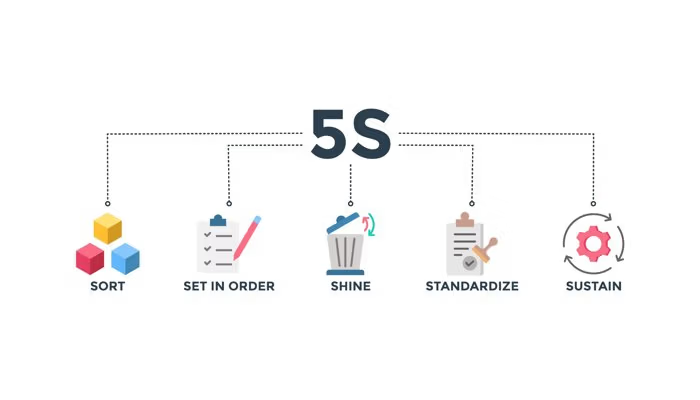Summary: Walking the production floor regularly reveals more than reports ever will. But whether those observations lead to real improvements depends on how the walk is structured. A Gemba Walk isn’t just a routine – it’s a method for closely observing processes where they happen. To make it meaningful, you need a checklist that asks the right questions: Where are the bottlenecks in your lean manufacturing process? Are standards being followed? Can you spot waste? This guide is designed for manufacturing leaders who want to conduct Gemba Walks to achieve measurable process improvements. You’ll get a clear, practical checklist- and see how structure and the right tools can turn everyday walks into a driver of lasting change.
Gemba in Action: It’s Not Just a Walk
Before we get into the checklist, let’s take a step back and figure out what exactly a Gemba Walk is. The word “Gemba” is Japanese and means “the real place.” In a factory, that’s the shop floor – where daily operations actually happen and where lean principles can be applied.
A Gemba Walk is when you, as a manager or supervisor, leave your desk and head out to the floor to see things for yourself. It’s not about checking up on people or micromanaging – as one team lead once told me, “We’re not here to point fingers. We’re here to see what the process is really asking of the people doing the work.”
You walk, observe, ask questions, and identify inefficiencies in the work environment. You talk to the workers, check out the processes, and look for small details others might miss. “Sometimes it’s the third time I walk the same path that I notice the tool station’s too far from where it’s needed,” a supervisor explained.
Instead of relying on dashboards or summaries, you’re seeing things with your own eyes. Think of it as moving from theory to practice – or as one production manager put it: “The floor tells you what your reports don’t.”
Why Gemba Walks Actually Work
Gemba Walks are effective when done regularly and with genuine intent, revealing key insights over time:
✔️ Uncover hidden waste: Often, inefficiencies are hidden in plain sight. For instance, a workstation might appear well-organized but still cause employees to retrace their steps for a missing tool. While this may not be raised in meetings, a brief observation reveals the issue.
✔️ Capture informal feedback: You also hear things you wouldn’t hear in formal settings. Small suggestions. Frustrations. Smart ideas. Workers usually don’t hand these over via email. But if you’re present – and clearly listening – the feedback comes naturally.
✔️ Identify process flaws: Over time, you’ll notice process gaps. Employees often develop workarounds when official procedures don’t align with reality. While this may seem like a failure, it presents an opportunity to identify areas for improvement.
✔️ Build trust: Trust is built gradually. It’s not about superficial gestures, but about consistency. Returning regularly and showing genuine attention fosters stronger, more trusting relationships.
Are Gemba Walks not yielding the insights you need to improve your operations?
flowdit helps you streamline Gemba Walks, ensuring real-time data capture and actionable insights.
Your 4-Step Framework for Effective Gemba Walks
Now that we’ve covered the basics, let’s take a look at four practical steps to make each walk more effective and focused.
1. Preparation: Clarify Your Focus
Before heading out onto the shop floor, it’s helpful to define what you want to observe. While part of a Gemba Walk is about open exploration, having a few priorities in mind helps keep you on track.
- Safety Compliance: Are safety standards being followed? Are there any obvious hazards that need attention?
- Productivity and Efficiency: Is everything running smoothly? Are there any noticeable downtimes, and if so, why?
- Quality Control: Are employees following proper quality assurance protocols? Are defects being caught in time?
Make sure your goals are clear before you start, but don’t over-plan. The point is to see what’s actually happening, not to have a rigid, predetermined approach.
2. Engagement: Talk to the Team
Don’t treat the Gemba Walk like a silent inspection. The real value often lies in what your team has to say. Talk to them directly and listen closely.
A few example questions:
- “What’s getting in your way today?”
- “If you could change one thing here, what would it be?”
- “Is there anything I can do to make your work easier?”
The goal here is not just to spot problems but to gather feedback from the frontline workers who know the processes best.
3. Observation: Keep an Eye on the Details
During the walk, keep your eyes open. Some areas you might focus on:
- Workplace Organization: Is the workspace clean and organized? Are tools and materials easy to find, or do they contribute to inefficiency in the workflow?
- Process Compliance: Are employees following standard operating procedures (SOPs)? Are there any deviations or shortcuts that could lead to future problems?
- Machine Performance: Are machines running smoothly? Are there signs of wear or malfunction?
- Employee Behavior: Are workers focused and engaged? Are they following the correct procedures? Are there any safety or operational concerns?
Make sure to document your observations, but avoid disrupting the flow unless absolutely necessary. The goal is to understand the reality of the situation, not to judge or interrupt the work.
4. Post-Walk Follow-Up: Turn Observations into Actions
After the Gemba Walk, it’s time to reflect on your findings and plan next steps. This is where the real work begins.
- Document Observations: Take detailed notes on what you observed- both positive and negative -for later data analysis. Be specific and categorize observations based on urgency and their impact on operations.
- Identify Actionable Insights: What’s the most urgent issue? Which areas need immediate attention, and which can wait? Be realistic about what can be fixed right away and what requires a longer-term solution.
- Collaborate with the Team: Discuss your findings with the relevant team members. Brainstorm ideas for improvement and agree on a plan of action.
- Monitor Progress: Gemba Walks are part of a continuous improvement process. Plan follow-up checks to ensure the changes are being implemented and are effective.
Gemba Walks provide valuable insights. For a structured approach, they can be complemented by Layered Process Audits. Discover the differences in our article on ‘Gemba Walk vs. Layered Process Audit: Which Approach Fits Better?’
Gemba Walk Checklist
Here’s a simple Gemba Walk checklist
Pre-Walk Preparation
Define the purpose and goals of the walk.
Review previous Gemba Walk reports and any outstanding issues.
Set a time frame for the walk (typically 30-60 minutes).
Inform relevant staff about the walk so they can be prepared.
Ensure you have any necessary tools, like a notebook or mobile device for notes.
Walkthrough Areas of Focus
A. Safety and Compliance
Are employees following safety protocols (e.g., wearing PPE)?
Are emergency exits and pathways clear?
Is the workplace compliant with industry regulations?
B. Workplace Organization
Are workstations clean and organized?
Are tools and materials easily accessible?
Is there a visual management system (e.g., labels, signs)?
C. Process Adherence
Are employees following standard work procedures?
Is there evidence of variations or shortcuts in processes?
Are machines and equipment being operated correctly?
D. Material Handling
Are materials flowing smoothly through the production process?
Are materials flowing smoothly through the production process?
Are there any bottlenecks or delays in material movement?
Is inventory management efficient and up-to-date?
E. Employee Engagement:
Is inventory management efficient and up-to-date?
Are employees engaged and focused on their tasks?
Do they have the tools and resources they need to be effective?
Are there any concerns or suggestions from employees regarding workflow or safety?
Post-Walk Follow-Up
Document key observations and issues.
Discuss findings with supervisors or relevant personnel.
Assign action items to address problems or opportunities for improvement.
Track the progress of any changes or improvements in subsequent Gemba Walks.
Communicate updates to the team and celebrate small wins.
📥 Download the Full Gemba Walk Checklist as PDF
Final Thoughts: Making Gemba Walks a Habit
Gemba Walks are an invaluable tool for manufacturing companies, offering real-time insights into your operations and fostering a culture of continuous improvement. With a structured approach they become a reliable source of actionable data and long-term progress in your work environment. By using the checklist provided, you’ll ensure that each walk is purposeful, consistent, and tied to clear follow-up actions. But managing observations, feedback, and improvements manually can quickly become time-consuming – especially across multiple teams or sites.
That’s why many manufacturing leaders are turning to digital checklist solutions. They simplify documentation, streamline collaboration, and ensure accountability at every step of the process.
Make Gemba Walks a regular part of your operations – with the right digital tools to support them – and over time, you’ll see a significant impact on productivity, quality, and employee morale.
Happy walking!
Image: Adobe Stock – Copyright: © bakhtiarzein – stock.adobe.com





